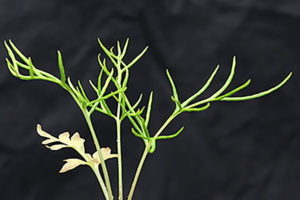Open Green Genomes hits milestone with C. richardii

As it turns out, Ceratopteris richardii has been hoarding and co-opting genes for millenia — making it both enormous and complex.(David Randall and Zhonghua Chen)
The Science
Fern genomes are huge, and incredibly complex — making it difficult to grasp a deeper understanding of fundamental aspects of fern biology and, more broadly, land plant evolution. Recent findings in Ceratopteris richardii show a long history of dynamic evolution and rapid changes in both genome content and structure following a genome duplication event that occured some 60 million years ago. Massive gene loss, rampant gene duplications, and even more ancient gene transfers from bacteria have all armed the plant with an array of defense mechanisms.
The Impact
There are over 10,400 species of ferns alive today. Boasting adaptations in order to protect themselves from environmental stresses, ferns’ secondary metabolites and associated genes are great resources for bioremediation, new agricultural applications or life-saving drugs. A better understanding of its genetic complexities will illuminate the evolutionary history of a pivotal plant as well as the evolution of seed plants, the fern’s distant cousin. Ceratopteris richardii, or C-fern, specifically has been studied in plant research laboratories and plant biology courses across the globe for insights into reproductive, space and genome biology.
The undeniable power of plants, and the lessons they can teach us, are why the U.S. Department of Energy (DOE) Joint Genome Institute (JGI), a DOE Office of Science User Facility located at Lawrence Berkeley National Laboratory (Berkeley Lab) took on the Open Green Genome Initiative in 2018 as part of its Community Science Program. The OGG has set out to generate high-quality genome assemblies and annotations for 35 species representing all major evolutionary lineages in the land plant tree of life. Ultimately, the resulting comparative framework can inform the efficient production of plant-based biofuels and bioproducts. (Learn more about OGG in this episode of to the JGI podcast Genome Insider.)
Summary
A recent paper published in Nature Communications on Ceratopteris richardii marks the first published manuscript of a genome sequence generated through the OGG. For a long time, C-fern has served as a model for studying ferns and for teaching plant biology. It is typical of most ferns in many ways, including its large genome with numerous chromosomes.
For a long time, this immense size and chromosomal hoarding had been thought to be the result of multiple whole-genome duplications. The process of genome-doubling, where an extra set of chromosomes is passed along to offspring supplying it with raw genetic materials and increased genome complexity, made sense. The problem with that theory was that the handful of documented WGDs in ferns could not explain the massive size of most fern genomes.
A team of researchers put together a chromosomal genome assembly and associated methylome, transcriptome and metabolome analyses for C-fern that was able to shed some light on the mystery. They found over seven million repetitive elements that account for 85.2% of the C-fern assembly. While they did identify a couple WGD events, these events could not fully account for the size and complexity of the C-fern’s genome.
Instead, it seems many of the fern’s defense-related gene families were snatched from bacteria. The insertion of transposable elements — also known as “jumping genes” because they can change position within a genome — into certain DNA segments has led the fern to its gene hoarding and those long genes. And gene family analysis showed that genes directing development of reproductive structures in seed plants were essentially co-opted from those directing spore development in the last common ancestor of seed plants and ferns.
The genome is available on the JGI’s plant portal, Phytozome. Researchers hope to have demonstrated the potential of ferns as sources of novel genetic material with applications including ecological remediation and bioprospecting — paving the way for C-fern to expand its role as a key plant system for teaching next-generation plant biology.
Contacts
BER Contact
Ramana Madupu, Ph.D.
Program Manager
Biological Systems Sciences Division
Office of Biological and Environmental Research
Office of Science
Department of Energy
[email protected]
PI Contact
James Leebens-Mack
Department of Plant Biology
University of Georgia
[email protected]
JGI Contact
Jeremy Schmutz
Plant Program Lead
DOE Joint Genome Institute
[email protected]
Funding
The work conducted by the US Department of Energy Joint Genome Institute is supported by the Office of Science of the US Department of Energy operated under Contract No. DE-AC02-05CH11231.This work was supported by US National Science Foundation (NSF; grant PRFB IOS-1907220 to D.B.M.; grant MCB-1856143 to R.J.S.; grant DEB-1911459 to P.G.W.; grant MRI-1828479 to B.A.A.); the Natural Science Foundation of China (NSFC; grant 32001456 to G.C.; grant 31771687 to S.C.; grant 41571049 to Y. Wu); China Agricultural Research Systems (grant CARS-05 to S.C.); the Key R&D Program of Zhejiang Province (grant 2021C02009 to S.X.) and Zhejiang Provincial Natural Science Foundation of China (grant LY21C130007 to D.X.).the Australian Research Council (grants FT210100366, DE1401011143 to Z.-H.C.); the Horticulture Innovation Australia (grants LP18000, VG17003 to Z.-H.C.). B.A.A. and D.W.S. acknowledge funding for this project from the Ambrose Monell Foundation.
Publication
Marchant DB et al. Dynamic genome evolution in a model fern. Nat. Plants. 1 Sept 2022. 8, 1038–1051. doi:10.1038/s41477-022-01226-7
Relevant Links
- Ceratopteris richardii on Phytozome
- JGI Genome Insider podcast: Filling in the Plant Tree of Life
- VIDEO: James Leebens-Mack at JGI’s 2022 User Meeting
- Florida Museum of Natural History story: Ferns finally get a genome, revealing a history of DNA hoarding and kleptomania